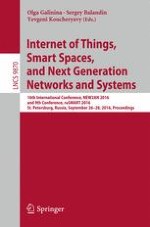This book constitutes the joint refereed proceedings of the 16th International Conference on Next Generation Wired/Wireless Advanced Networks and Systems, NEW2AN 2016, and the 9th Conference on Internet of Things and Smart Spaces, ruSMART 2016, held in St. Petersburg, Russia, in September 2016. The 69 revised full papers were carefully reviewed and selected from 204 submissions. The 12 papers selected for ruSMART are organized in topical sections on new generation of smart services; smart services serving telecommunication networks; role of context for smart services; and smart services in automotive industry.
The 57 papers from NEW2AN deal with the following topics: cooperative communications; wireless networks; wireless sensor networks; security issues; IoT and industrial IoT; NoC and positioning; ITS; network issues; SDN; satellite communications; signals and circuits; advanced materials and their properties; and economics and business.
